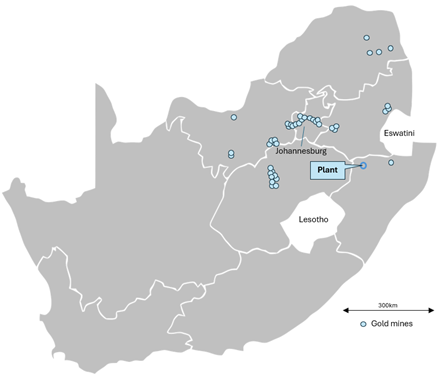

Metals One (AIM: MET1, OTCQB: MTOPF), a critical and precious metals exploration and development company, is pleased to announce it is making a strategic investment of up to US$1.8 million in Lions Bay Resources (‘LBR’) by way of convertible loan notes (‘CLN’).
LBR is a South African private company formed earlier this year to hold partnership assets. It is jointly owned by Lions Bay Capital Inc. (‘Lions Bay’) (TSX-V: LBI) (Metals One: 19.1%) and by the Salamander Mining management team (‘Salamander’) headed by Graham Briggs (Non-Executive Chairman), the former CEO of Harmony Gold, South Africa’s largest gold producer and Lloyd Birrell (CEO), the founder and former CEO of Theta Gold (ASX:TGM).
LBR has secured an option for US$1.36 million over a large cogeneration plant located in the Karbochem Industrial Park, Newcastle, South Africa (‘Plant’). Research and planning has commenced around modifying the Plant to produce power and steam whilst also roasting refractory gold concentrates, common to mines in the region. Metals One and LBR have recently conducted due diligence on the Plant and have agreed to apply part of the funds from the CLN to exercising the option.
The Plant currently has the below specifications and associated infrastructure:
- 2 x 30 tonnes per hour (‘TPH’) Thermax combustion boilers
- 6 MW GE-Triveni steam turbine
- The Plant is configured to take coal from local dumps and biomass as feedstock
- Boiler house, turbine, control room and motor control centre
- Compressed air plant and electrical sub-station
- Inclined conveyor to six silos (1,500m3 each)
The Plant was inspected and verified by Terravista Solutions P. Ltd in October 2025 and ascribed a replacement value of US$39.6 million. Subject to receipt of a competent persons report, to be funded from the proceeds of the CLN, it is expected that the Plant will require approximately US$4.5 million to restart production of steam and power.
A large chrome smelter operation adjacent to the Plant, requiring power and steam, has been engaged and discussions around a mutually beneficial offtake agreement are underway.
Pending confirmatory research and studies, LBR plans to reconfigure the Plant to include a gold concentrate roasting complex, an alternative solution to exporting gold-bearing concentrate from South Africa to Asian smelters. This process has the potential to create a further revenue stream for the Plant by toll processing material from regional mines, while sustaining production of steam and power. At the election of Metals One, part of the proceeds from the CLN will be applied to commissioning a further technical report on the reconfiguration of the Plant to include a gold roaster.
The region is host to numerous multi-million-ounce gold deposits and tailings resources, the mining of which generate concentrate, all within a 300km radius of the Plant. In addition to the larger mining complexes, there are several small deposits which are unable to satisfy the high capital requirements of standalone operations that would benefit from a large centralised roasting facility such as LBR’s.
The near-term strategy for LBR is to acquire regional gold mining and tailings assets as potential feedstock for the gold roaster. Metals One and LBR have been working together on identifying acquisition opportunities that suit the potential configuration of the Plant and gold roaster, some with substantial gold inventory and mining infrastructure.
|

|
|
Figure 1: Map of South African historical and operating gold mines in the region.
Source: Council for Geoscience, South Africa 2015.
|
CLN
Metals One has conditionally agreed to subscribe for up to US$1.8 million CLNs in LBR in tranches, subject to the satisfaction of certain conditions in respect of each tranche, as below.
- Metals One being satisfied with legal, financial and technical due diligence on LBR and its assets (including the Plant)
- In respect of tranche 1, a technical report confirming the replacement value of the Plant having been issued by a competent person
- In respect of tranche 2, LBR and Lions Bay having entered into legally binding transaction documents in respect of the Plant pursuant to which LBR will acquire a 100% legal and beneficial interest in the Plant
- First ranking security, in agreed form having been granted to Metals One
- The warranties and representations remain true and accurate in all respects
- LBR and Lions Bay having complied with all its obligations under the agreement
- LBR having obtained shareholder and board approval, to the extent required, to issue the CLNs and to allot shares on a conversion
- No event of default having occurred and is continuing
It is expected that tranches 1 and 2 will be for US$175,000 and US$1.625 million respectively. Any further tranches are to be made available at Metals One’s discretion and Metals One is to have the ability to require LBR to draw down amounts.
In consideration for Metals One’s subscription, LBR has agreed to issue Metals One such number of new shares on the date of the convertible loan note instrument as is equal to 5% of the issued share capital of LBR on a fully diluted and enlarged basis (‘Introduction Shares’).
The CLNs are to be redeemable for cash on an event of default or at the option of Metals One on first anniversary of the grant of the respective CLNs (the ‘Maturity Date’).
Metals One is to have the option to convert the CLNs into the most favourable class of shares in the capital of LBR in certain circumstances, including (but not limited to) on LBR acquiring the plant and on the relevant Maturity Date.
Assuming that Metals One advances the full US$1.8 million to LBR, upon conversion of the CLNs, Metals One’s shareholding in LBR is to be at least 30% of the issued share capital of LBR on a fully diluted and enlarged basis. Until conversion or redemption, the CLN attracts a 10% coupon that compounds annually that is to be rolled up and become payable in cash on the relevant Maturity Date or convertible into LBR shares, at the election of Metals One.
The CLNs are to be secured, amongst other things, by first ranking security over the assets of LBR.
|

|
|
Figure 2: Aerial photograph of the Plant, taken on the Metals One site visit.
|
Dan Maling, Managing Director of Metals One, commented:
‘South Africa is historically the world’s largest gold producer, and we believe it has the perfect ingredients of abundant resources, infrastructure and mining expertise to become a leader once again.
With the acquisition of the gold roaster and associated infrastructure, alongside the experienced mining team at Salamander, LBR has the foundations to be a significant, vertically integrated South African gold company.
Metals One remains well financed with over £9 million in cash and liquid investments. Our network and ready access to capital enables us to facilitate downstream acquisitions such as this. We look forward to providing further updates on the growth opportunities with Lions Bay Resources in the coming months.’
Enquiries:
|
Metals One Plc
Daniel Maling, Managing Director
Craig Moulton, Chairman
|
info@metals-one.com
+44 (0)20 7981 2576
|
|
Beaumont Cornish Limited (Nominated Adviser)
James Biddle / Roland Cornish
|
+44 (0)20 7628 3396
|
|
Capital Plus Partners Limited (Broker)
Jonathan Critchley
|
+44 (0)207 432 0501
|
|
Vigo Consulting (UK Investor Relations)
Ben Simons / Fiona Hetherington / Anna Stacey
|
IR.MetalsOne@vigoconsulting.com +44 (0)20 7390 0230
|
|
Fairfax Partners Inc (North America Investor Relations)
|
connect@fairfaxpartners.ca
+1 604 366 6277
|
About Metals One
Metals One is pursuing a strategic portfolio of critical and precious metals projects and investments underpinned by the Western World’s urgent need for reliably and responsibly sourced raw materials – and record high gold prices. Metals One’s shares are listed on the London Stock Exchange’s AIM Market (MET1) and on the OTCQB Venture Market in the United States (MTOPF).
Map of Metals One projects/investments

Follow us on social media:
LinkedIn: https://www.linkedin.com/company/metals-one-plc/
X: https://x.com/metals_one_PLC
Subscribe to our news alert service on the Investors page of our website at: https://metals-one.com
Market Abuse Regulation (MAR) Disclosure
The information set out below is provided in accordance with the requirements of Article 19(3) of the Market Abuse Regulations (EU) No. 596/2014 which forms part of UK domestic law by virtue of the European Union (Withdrawal) Act 2018 (‘MAR’).
Nominated Adviser
Beaumont Cornish Limited (‘Beaumont Cornish’) is the Company’s Nominated Adviser and is authorised and regulated by the FCA. Beaumont Cornish’s responsibilities as the Company’s Nominated Adviser, including a responsibility to advise and guide the Company on its responsibilities under the AIM Rules for Companies and AIM Rules for Nominated Advisers, are owed solely to the London Stock Exchange. Beaumont Cornish is not acting for and will not be responsible to any other persons for providing protections afforded to customers of Beaumont Cornish nor for advising them in relation to the proposed arrangements described in this announcement or any matter referred to in it.
Source
This post appeared first on investingnews.com






 South Harz Potash Limited (SHP:AU) has announced Investor Presentation Scandinavian Copper-Gold Project
South Harz Potash Limited (SHP:AU) has announced Investor Presentation Scandinavian Copper-Gold Project







 Aurum Resources (AUE:AU) has announced Aurum completes $22.98M Montage share sale
Aurum Resources (AUE:AU) has announced Aurum completes $22.98M Montage share sale

 Altech Batteries (ATC:AU) has announced Altech – Board and Management Changes
Altech Batteries (ATC:AU) has announced Altech – Board and Management Changes

















